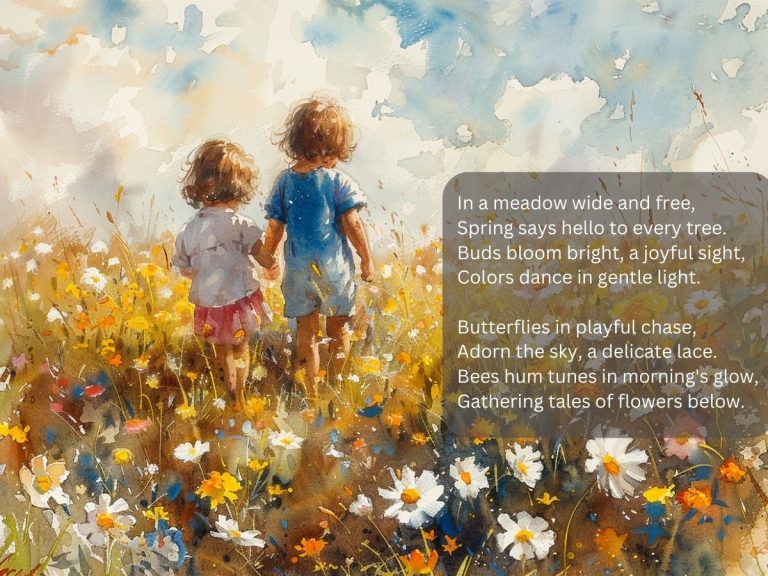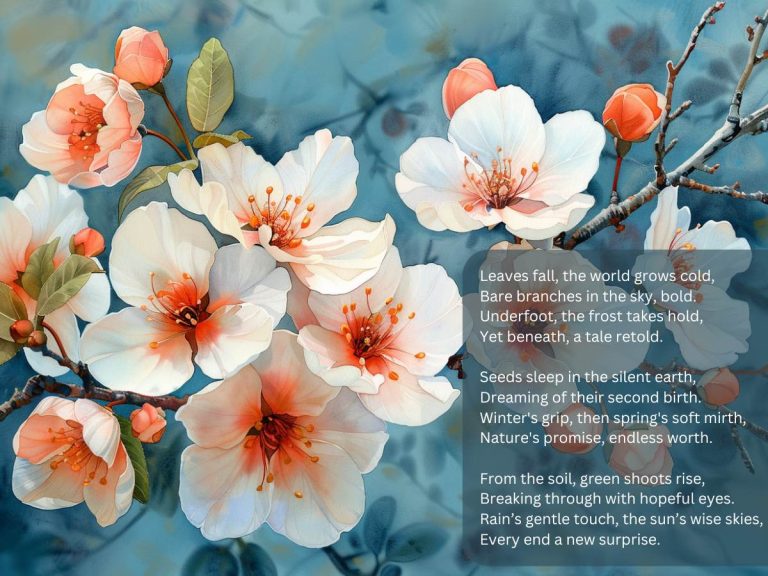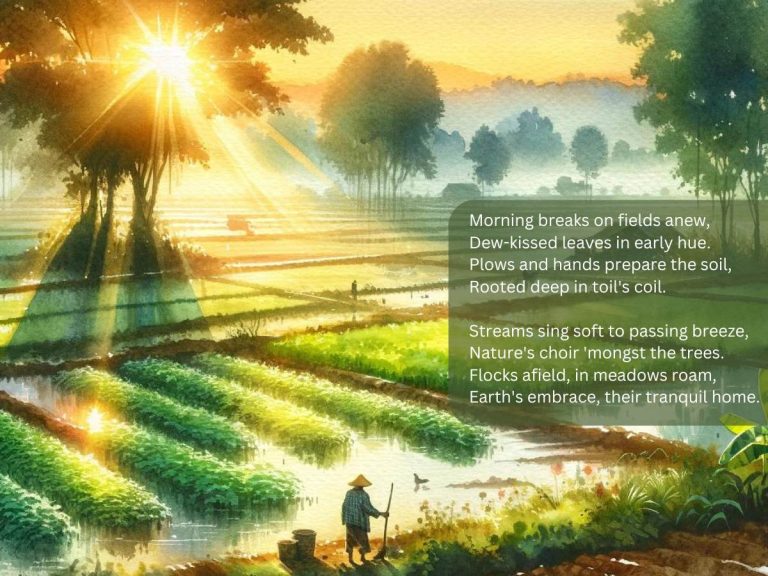March Haikus
Table of Contents
March’s Awakening
Buds stir in silence,
March whispers to sleeping earth,
Spring's first breath unfolds.
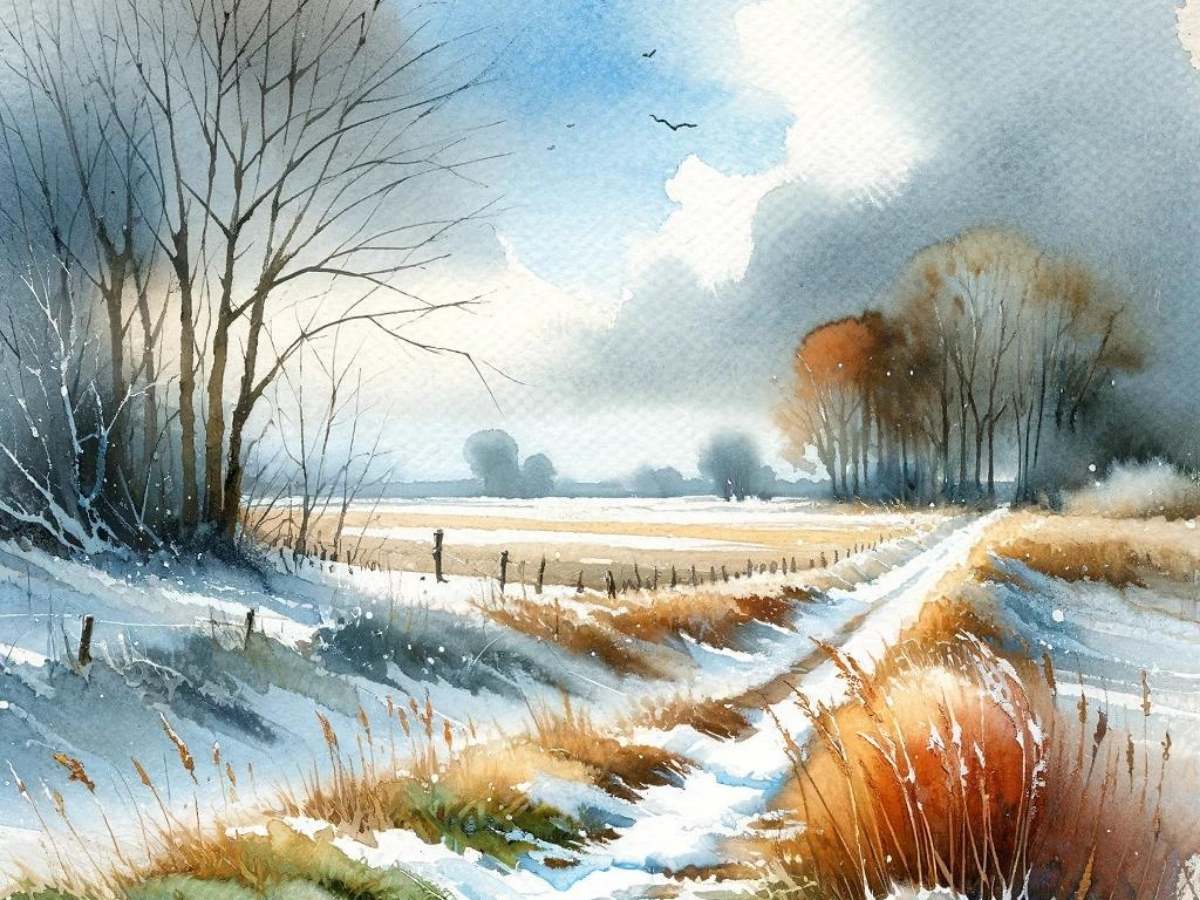
Meaning
This haiku captures the essence of early spring as March ushers in a period of awakening and renewal. It depicts the gentle and almost imperceptible transformation of nature as the last grips of winter loosen. The imagery of buds stirring in silence evokes a sense of quiet anticipation, while the mention of March whispering to the earth personifies the month as a harbinger of change. The final line, “Spring’s first breath unfolds,” symbolizes the emergence of life and the beginning of a new cycle, encapsulating the hopeful spirit of spring.
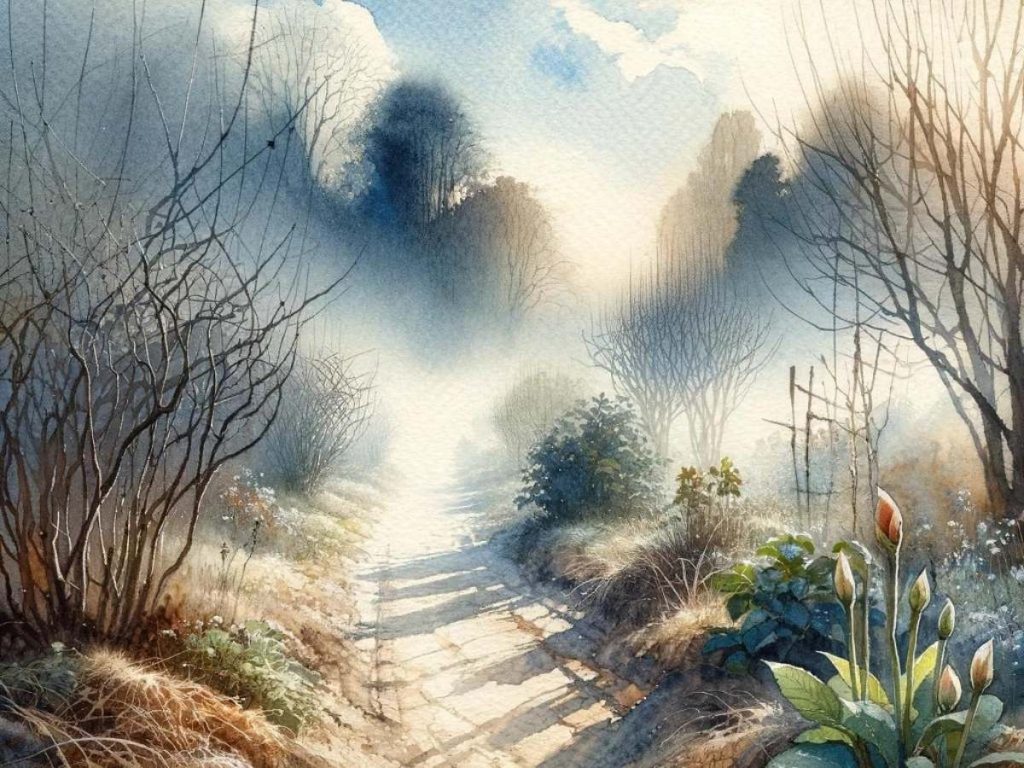
Inspiration Behind
As I walked through the garden, the subtle signs of spring’s approach inspired me. The way the dormant buds seemed to quiver with life, eager to burst forth, spoke to me of nature’s resilience and its cycles of renewal. March, with its unique position as the bridge between winter and spring, seemed like a quiet conductor orchestrating this symphony of awakening. This haiku was born from my reflections on these moments, aiming to capture the delicate balance of stillness and growth that characterizes this time of year.
Whisper of Rebirth
March's crisp air bites,
Green whispers beneath snow's veil,
Life's rebirth awaits.
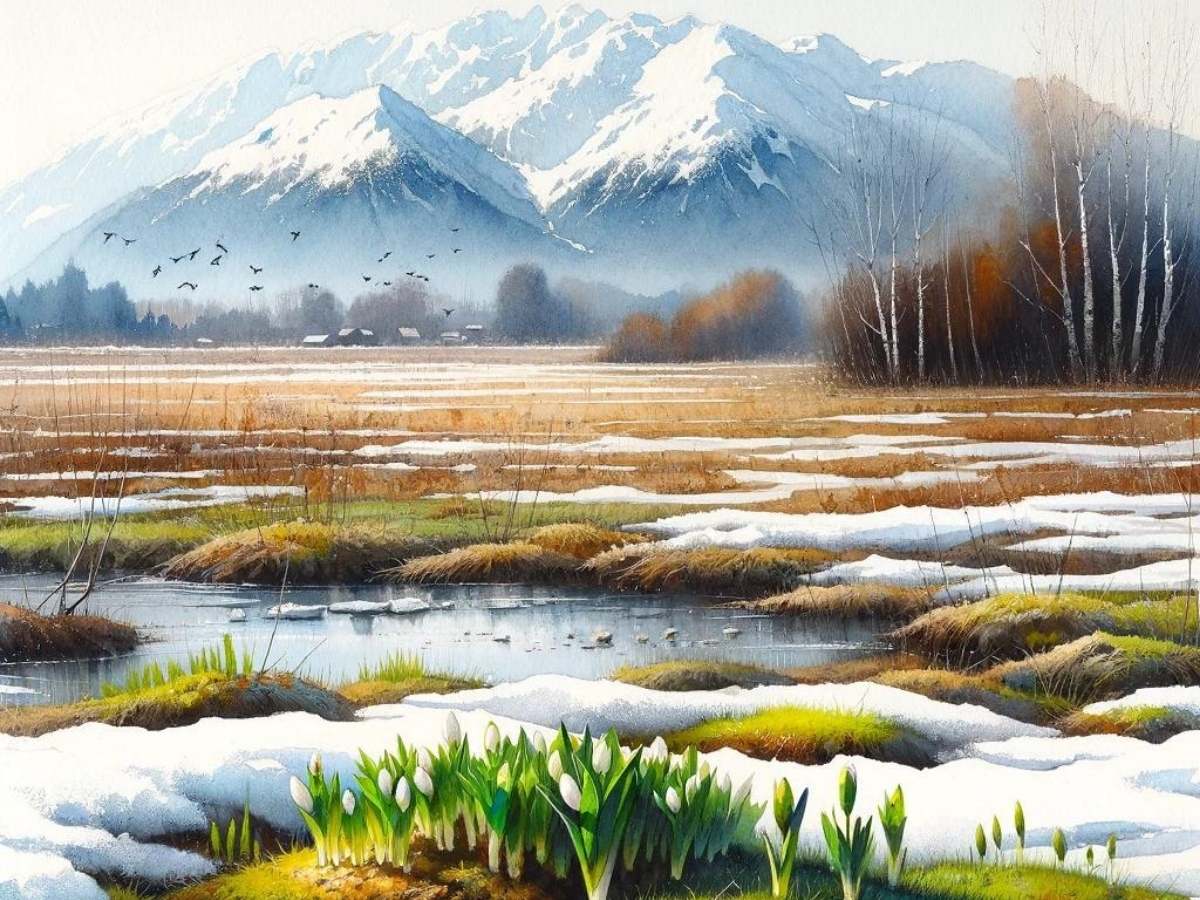
Meaning
This haiku paints a vivid picture of the transitional phase that March represents, caught between the tail end of winter’s chill and the onset of spring’s renewal. The first line, “March’s crisp air bites,” conveys the lingering cold of winter, setting a scene that feels both fresh and brisk. The second line, “Green whispers beneath snow’s veil,” introduces the hidden, yet imminent, resurgence of life waiting just under the snow-covered landscape. It suggests a secret conversation between the earth and the coming warmth. The final line, “Life’s rebirth awaits,” is a promise of the impending revival of nature, capturing the anticipation and hope that defines the month of March.
Inspiration Behind
While observing the late winter landscape, I was struck by the resilience of nature and its cyclical promise of renewal. The juxtaposition of the remaining snow with the first signs of green breaking through inspired a reflection on the quiet yet powerful transition from winter to spring. March, with its fluctuating moods, embodies this period of waiting and potential. This haiku is my attempt to capture the essence of this moment— a pause before the burst of life that spring brings, where every element of nature whispers of the transformations to come.
March’s Mellow Glow
Sun melts snow to tears,
March cradles the waking earth,
Blossoms whisper hope.
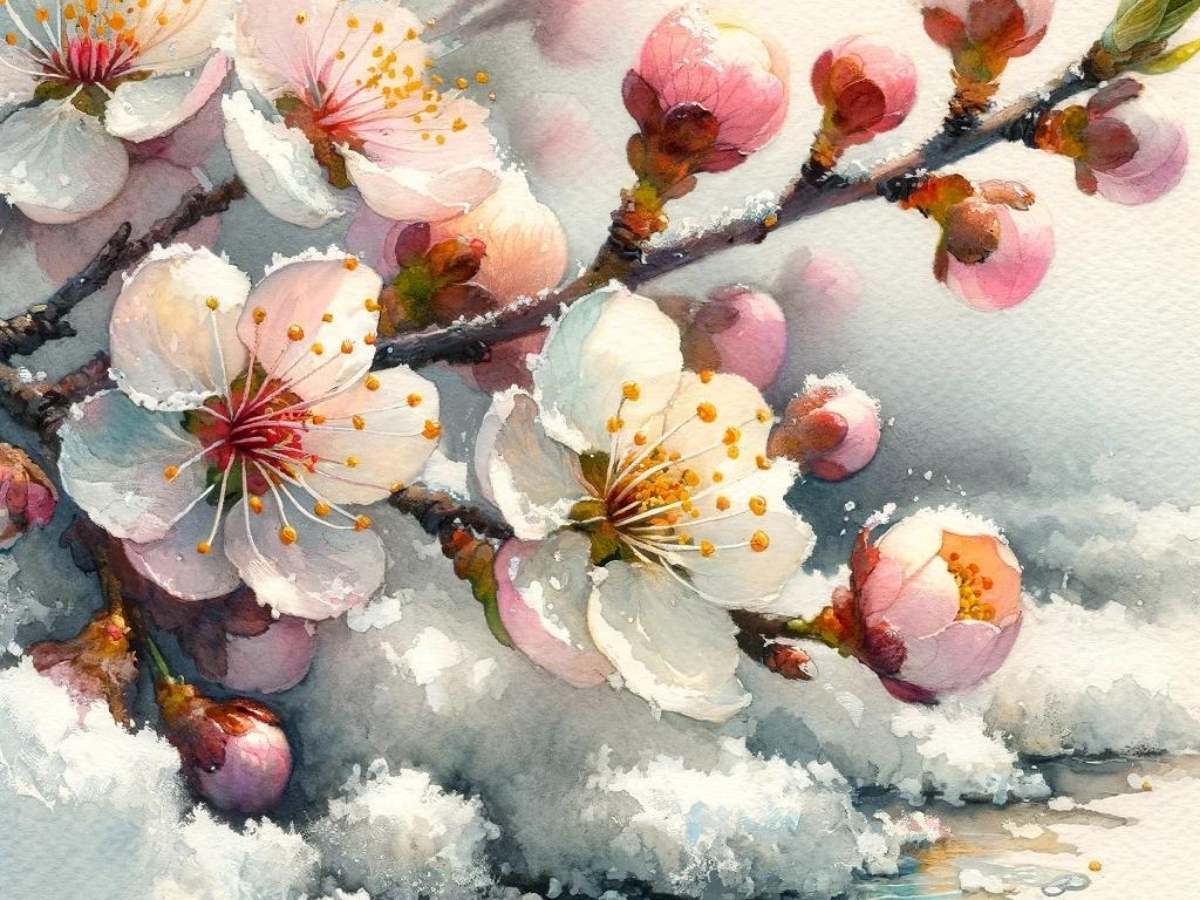
Meaning
This haiku encapsulates the transformative energy of March as it bridges the gap between the cold of winter and the warmth of spring. The imagery of the sun melting snow into tears symbolizes the end of winter’s harshness and the beginning of a more forgiving season. March is personified as a nurturing force, cradling the waking earth back to life, suggesting a tender care in the transition. The final line, “Blossoms whisper hope,” speaks to the subtle yet profound signs of new growth and renewal, offering a promise of rejuvenation and the optimism that spring brings.
Inspiration Behind
During a stroll in the early days of March, I was captivated by the gentle thawing of the landscape. The sight of sunlight casting a mellow glow over the snow, transforming it into water droplets, struck me as a beautiful metaphor for renewal and hope. It reminded me of nature’s resilience and its cyclical promise of rebirth. This haiku attempts to capture the essence of that moment—a time when the earth itself seems to pause and whisper promises of the beauty yet to come.
Dusk in March’s Embrace
Evening shadows stretch,
March's chill whispers to stars,
Dusk's quiet promise.

Meaning
This haiku captures the serene and contemplative mood of a March evening as the day transitions into night. The first line, “Evening shadows stretch,” paints a picture of the elongating shadows at dusk, symbolizing the day’s end and the approach of night. The second line, “March’s chill whispers to stars,” personifies the month’s lingering cold as a soft conversation with the emerging stars, highlighting the blend of winter’s tail and the anticipation of spring. The final line, “Dusk’s quiet promise,” suggests the hopeful and peaceful promise that nightfall brings, embodying the quiet before the renewal of dawn and the progression into warmer days.
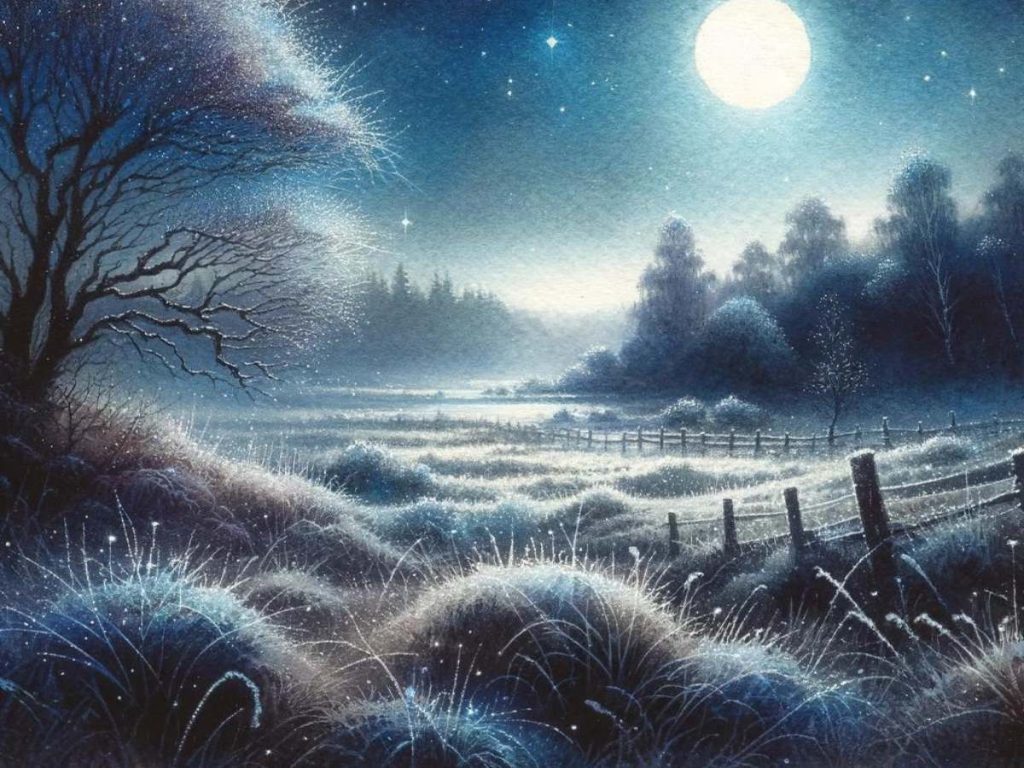
Inspiration Behind
One March evening, as I watched the sky transition from day to night, I was struck by the beauty and tranquility of the moment. The way the shadows grew longer and the first stars began to twinkle in the twilight sky inspired a sense of peace and reflection. This haiku emerged from that moment of contemplation, aiming to capture the subtle beauty of March evenings—where the cold of winter and the promise of spring coexist, and the world seems to hold its breath in the quiet promise of the coming night.
March’s Farewell Song
Bare trees stand in wait,
March ends with a soft sunset,
Spring's door gently opens.

Meaning
This haiku reflects on the transition from March to April, capturing the moment when winter’s starkness begins to give way to the first signs of spring. The image of “Bare trees stand in wait” evokes a sense of anticipation, as the natural world prepares for the coming change. The phrase “March ends with a soft sunset” symbolizes the closing of one chapter and the subtle beauty found in these moments of change. Finally, “Spring’s door gently opens” offers a hopeful glimpse into the future, suggesting the arrival of spring and the renewal it brings.
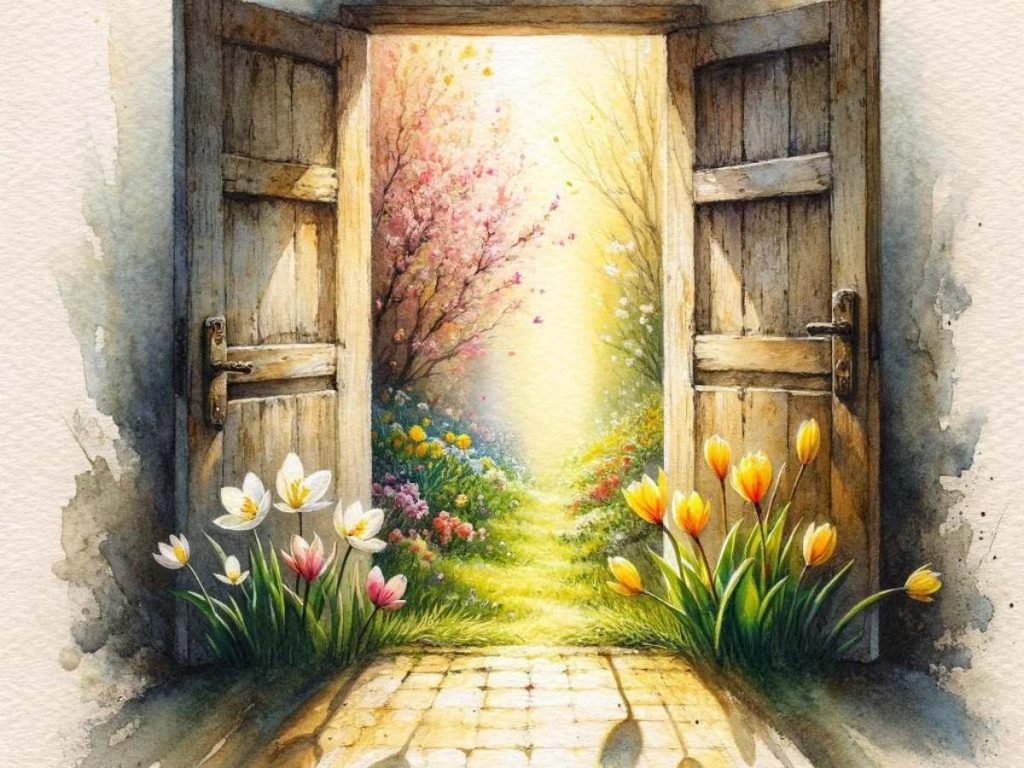
Inspiration Behind
As I observed the changing landscape at the end of March, I was struck by the quiet beauty of the season’s transition. The sight of bare trees silhouetted against the backdrop of a soft sunset inspired me to reflect on the moments of stillness and anticipation that precede significant changes. This haiku was born from those reflections, aiming to capture the delicate balance between ending and beginning that defines this time of year.
March’s Soft Echo
Rain taps on windows,
March hums a soft melody,
Spring dances close by.
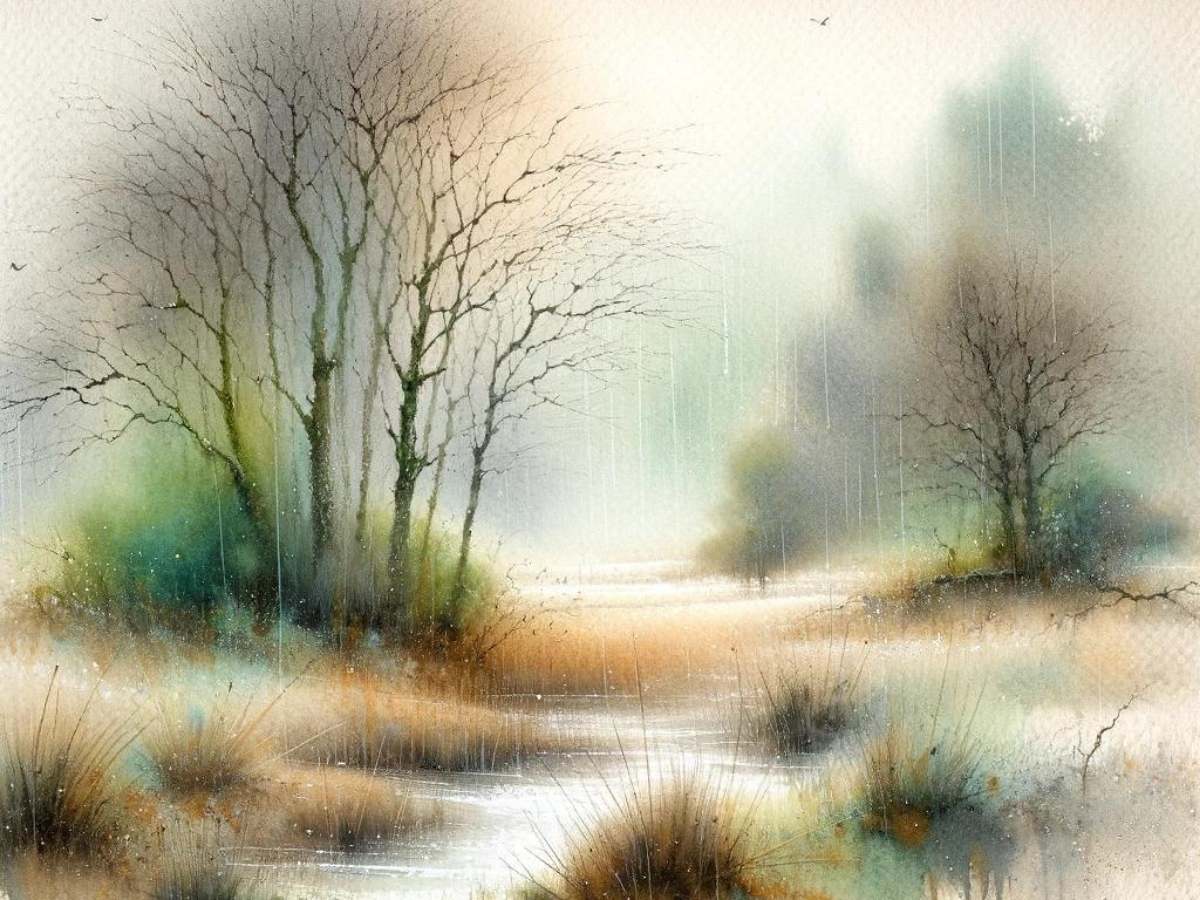
Meaning
This haiku captures the gentle, rhythmic essence of March, portraying it as a time of gentle transformation and anticipation. The imagery of rain tapping on windows conveys the soothing, persistent presence of spring showers, which are both literal and symbolic of renewal. The phrase “March hums a soft melody” personifies the month as quietly vibrant and alive, filled with the subtle sounds of nature reawakening. The final line, “Spring dances close by,” evokes the imminent arrival of spring, suggesting movement and the joyous energy of the season waiting just at the threshold.

Inspiration Behind
Inspired by a quiet afternoon in March, watching raindrops trace paths down the windowpane, I felt a deep connection to the slow but sure transition from winter to spring. The world outside seemed to be humming its own tune, a soft melody of growth and renewal. This haiku is a reflection of that moment—capturing the anticipation for the full bloom of spring, while still savoring the gentle, nurturing rains of March. It’s about finding beauty in the quiet, subtle shifts that herald the arrival of new beginnings.
March’s Gentle Thaw
Frost yields to sun's gaze,
March unfolds in thawing hues,
Nature's sigh of ease.
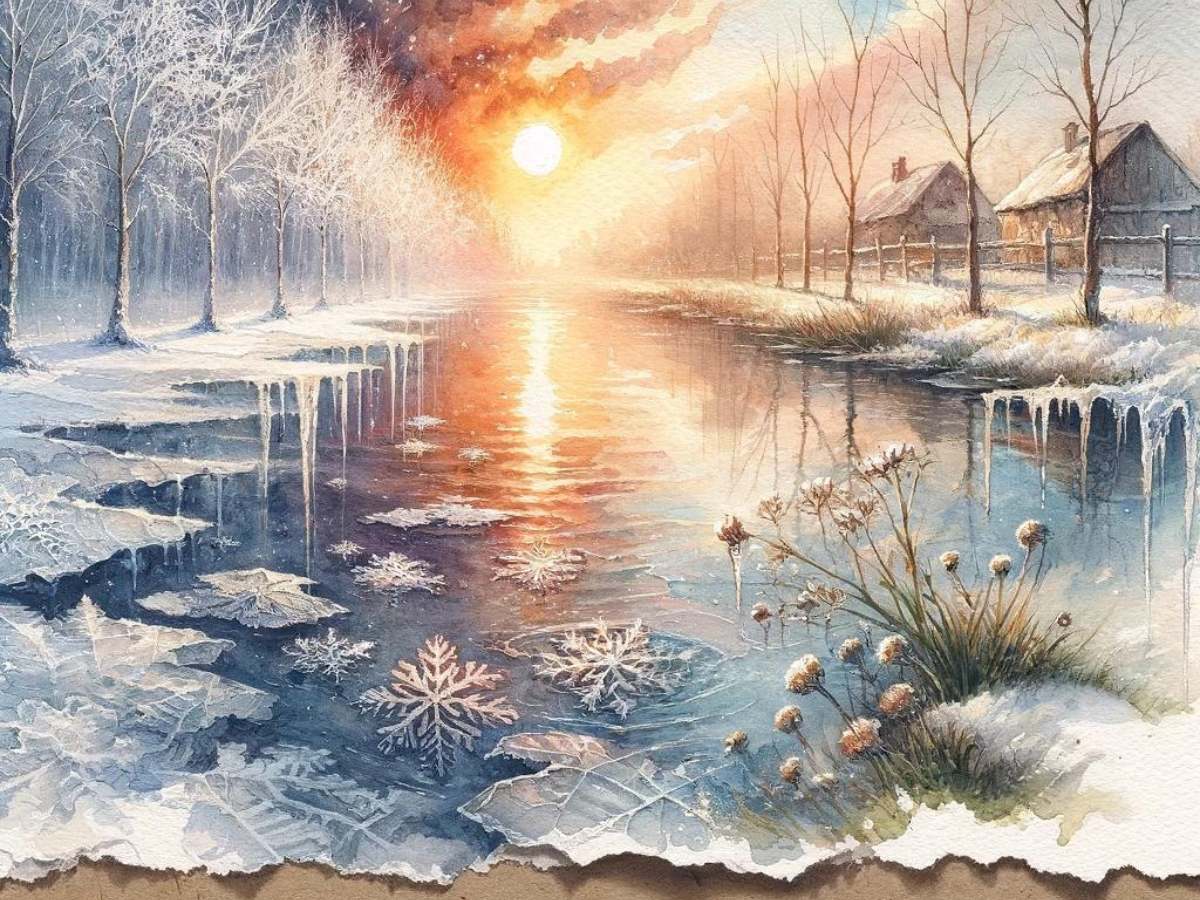
Meaning
This haiku captures the essence of early spring as witnessed in March, where the lingering frost begins to melt under the warmth of the sun’s gaze. The imagery of “Frost yields to sun’s gaze” symbolizes the retreat of winter as warmth slowly takes over, signifying a time of gentle transition. “March unfolds in thawing hues” portrays the landscape coming to life with colors and textures that were dormant under the snow, suggesting a visual and sensory awakening. The final line, “Nature’s sigh of ease,” evokes a sense of relief and renewal as the natural world emerges from the cold embrace of winter, ready to embrace the growth and vitality of spring.
Inspiration Behind
The inspiration for this haiku came from a walk through the countryside in early March. Witnessing the subtle yet profound transformation of the landscape from the cold, stark whites of winter to the first signs of thawing ground and budding life filled me with a sense of peace and wonder. The gentle thaw felt like nature’s own way of exhaling, releasing the tension of the colder months in preparation for the rebirth of spring. This poem attempts to capture that moment of transition, reflecting on the beauty and tranquility found in nature’s cyclical journey.
March’s Whispering Wind
Frost yields to sun's gaze,
March unfolds in thawing hues,
Nature's sigh of ease.
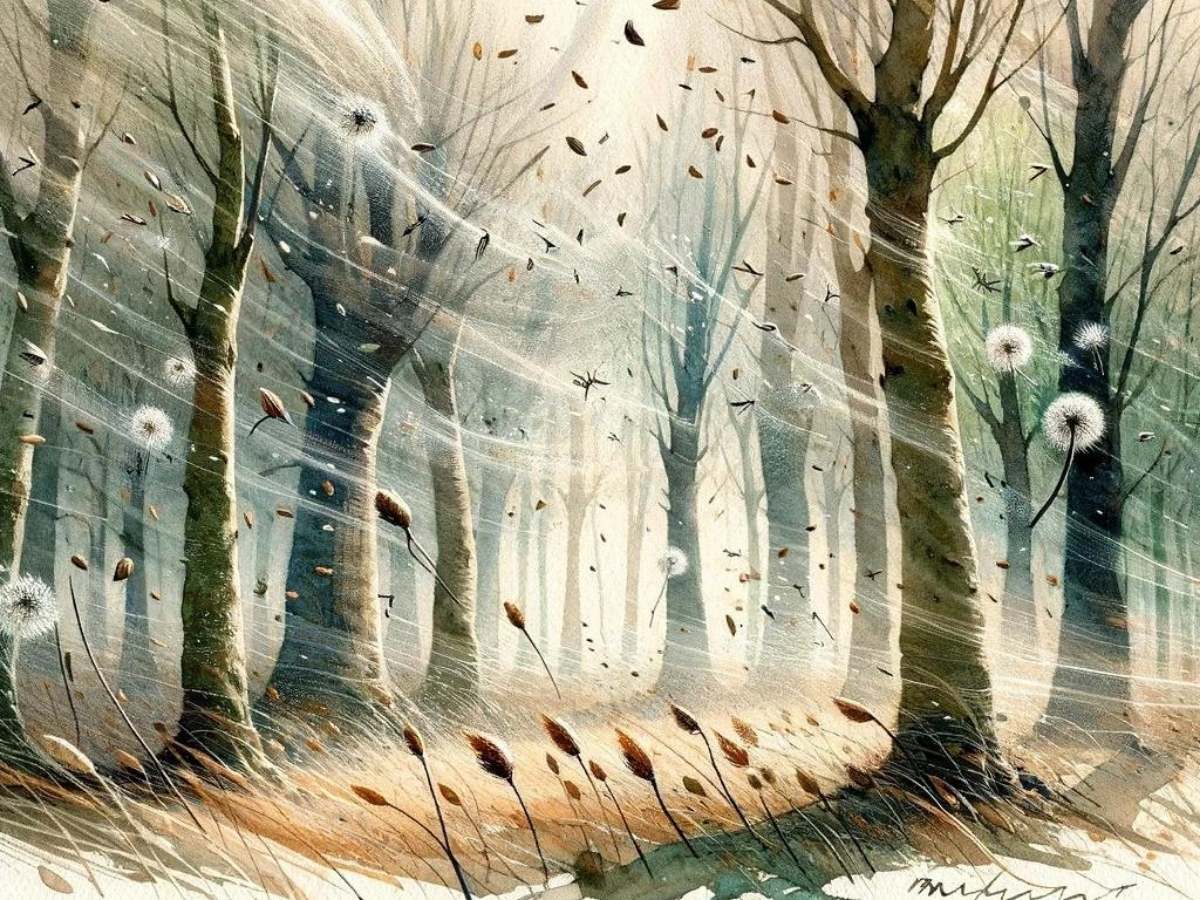
Meaning
This haiku embodies the dynamic and rejuvenating spirit of March, highlighting the natural processes that mark the transition from winter to spring. The “Wind dances through trees” line captures the lively movement and energy characteristic of March’s breezes, which play a vital role in the natural world’s awakening. “March scatters seeds of new life” personifies the month as an active participant in renewal, dispersing potential across the landscape. The concluding line, “Earth awakens, stirred,” conveys the response of the natural world to these stimuli—a gradual but inevitable reawakening that brings the promise of renewal and growth.
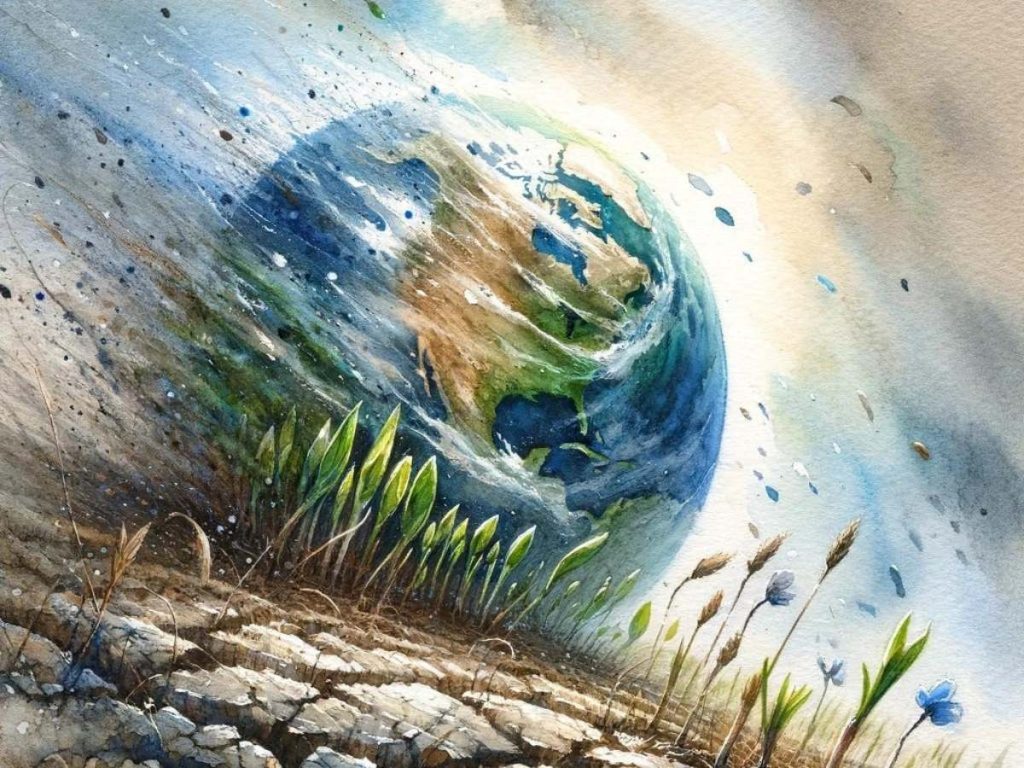
Inspiration Behind
While observing the forceful yet playful March wind, I was inspired by its unseen but deeply felt influence on the environment. It struck me as a powerful force for change, carrying with it the seeds of the future, ready to take root. This haiku came from a desire to capture the essence of this transition, focusing on the wind as a metaphor for the unseen energies that drive renewal and growth. It reflects a moment of connection with the natural cycle, recognizing March’s unique role in heralding the arrival of spring.
End Words
These March Haikus and their accompanying watercolor paintings offer a lyrical journey through March, capturing the essence of a month that stands at the crossroads of winter and spring. Each poem delves into the subtle transformations and quiet promises hidden within the days of March, from the awakening of dormant seeds to the soft whispers of change carried by the wind. Together, they weave a tapestry of anticipation, renewal, and the delicate dance of nature as it transitions from the cold embrace of winter to the hopeful warmth of spring. Through vivid imagery and evocative language, these pieces celebrate the beauty and resilience of the natural world, reminding us of the constant cycle of rebirth that surrounds us.



